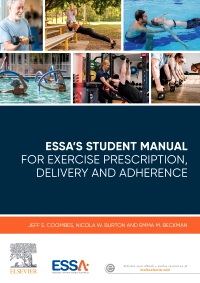
ESSA’s Student Manual for Exercise Prescription, Delivery and Adherence- eBook, 1st Edition
Elsevier eBook on VitalSource

Now $56.69
Endorsed by Exercise & Sports Science Australia (ESSA)
ESSA is a professional organisation which is committed to establishing, promoting and defending the career paths of tertiary trained exercise and sports science practitioners. s
ESSA’s Student Manual for Exercise Prescription, Delivery and Adherence is a unique text that covers not only how to write and deliver exercise programs, but also how to support and enable people to stick to them for better health and wellbeing.
Expert academic authors Jeff Coombes, Nicola Burton and Emma Beckman have precisely mapped the contents to Australian essential professional standards, making this text suitable for students of all ESSA-accredited degree and postgraduate courses wanting to gain accreditation in exercise science and exercise physiology.
The text combines theory and practical exercises to boost competency and confidence. It covers everything students need to know, from required foundational knowledge of biomechanics, functional anatomy, physiology and associated psychology and how to apply that to create, deliver, and support safe and effective exercise.
-
- Current exercise/physical activity guidelines (including for weight loss, young children and adolescents, pregnancy and older individuals)
- Contemporary approaches to exercise prescription (e.g. use of autoregulation and repetitions-in-reserve to prescribe resistance training)
- Comprehensive step-by-step suite of exercises for all body parts
- Practical activities to understand and experience high intensity interval training
- Evidence-based behaviour change frameworks to understand and promote exercise adherence with accompanying practical activities
- Relevant to ESSA accreditation standards for Exercise Scientists, Sport Scientists and Exercise Physiologists in Australia
-
Section 1- Exercise programming
Practical 1: Introduction to exercise programming
Practical 2: Designing an exercise program
Practical 3: Exercise programming for healthy populations with special considerationsSection 2- Exercise delivery
Practical 4: Aerobic exercise
Practical 5: The trunk
Practical 6: The chest
Practical 7: The shoulders and arm
Practical 8: The back
Practical 9: The legs
Practical 10: Exercise for maximal strength, power and speed
Practical 11: Flexibility exercises
Practical 12: Exercise in water
Practical 13: Group training exercise
Practical 14: Neuromotor and functional fitness trainingSection 3- Exercise adherence
Practical 15: Understanding exercise non-adherence
Practical 16: Promoting exercise adherence
Practical 17: Behavioural counselling for exercise

 as described in our
as described in our 